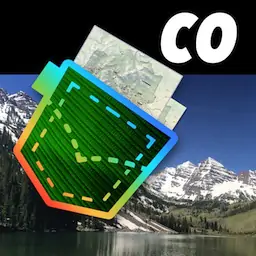"Scenic view from atop Twin Rock" by U.S. National Park Service , public domain
Paleontology Program at the MonumentFlorissant Fossil Beds |
featured in
| National Parks Pocket Maps |  | |
| Colorado Pocket Maps |  |
Florissant Fossil Beds
Paleontology Program
U.S. Department of the Interior
National Park Service
Florissant Fossil Beds
National Monument
The paleontology staff at Florissant Fossil Beds National Monument includes a paleontologist, a museum
technician, and several interns. These specialists monitor fossil sites around the monument, curate fossils in
the on-site museum, and work with scientists at other institutions conduct to research about Florissant.
Is anyone still digging for fossils?
Researchers from various institutions have dug for fossils at
Florissant, but any excavation on National Park Service land
requires a permit. There
are no large excavations
currently planned
because there is not
enough room for more
fossils in the monument
museum. The most
recent large dig occurred
over the summers of 2009
and 2010 as part of a
master’s thesis. Other
research has led to small
digs since then.
A paleontology intern splits shale.
Keeping an eye on the fossils
Paleontology staff have monitored the stumps and other
geologic resources in the park every summer since 1992. They
photograph each site from specific angles and compare
photographs from different years to determine how the site
has changed. An evaluation form for each site quantifies
disturbances such as erosion, animal burrows, research
excavations, and theft. In general, most sites change very little
in a year and theft is rare, but it is important to continue
monitoring the resources to ensure that adequate protection
measures are in place to preserve the monument’s resources.
Where are all the excavated fossils?
The paleontology lab in the visitor center building includes a
room for museum collections. More than ten thousand objects
are cataloged in the museum, and most of these are plant or
insect fossils. Other museums across the U.S. and U.K. hold
tens of thousands more fossils from excavations at Florissant
done before the site was protected as a national monument.
Conserving Fragile Fossils
The monument does ongoing and pioneering experiments to
find the best ways to care for the fossils at Florissant.
Petrified Wood
Paleontology staff regularly
monitor the the stumps
behind the visitor center.
These fossils were shattered
when they were historically
excavated with dynamite.
The monument has worked
Metal bands are installed
to stabilize the stumps with
around a cracked stump.
metal retaining bands and
overhead shelters. New projects are ongoing with the
University of Pennsylvania to test stone masonry
conservation techniques on the most fragile stumps.
Paper Shale
The shale containing Florissant fossils is made of paperthin layers of ash and microorganisms called diatoms.
The shale splits, flakes, and cracks with temperature and
humidity changes or
contact with chemicals.
The paleontology staff
are studying ways to
repair and prevent
damage to the shale
fossils in the monument
collections.
1
What happens to the fossils after excavation?
Fossil specimens easily break or become lost if they are not properly cared for.
Museum staff at Florissant Fossil Beds National Monument record, photograph, and
permanently store each fossil collected in the park. Some fossils are also prepared and
studied for scientific research.
3
Fossils are cushioned in a small
box with foam.
Preparation
When shale is split to reveal a fossil, often parts of the shale still cover
the edges of the specimen. Paleontology preparators (people trained to care
for fossils) use needle-like tools to pick the shale away, revealing the fossil
underneath. The antennae (shown by arrows) of this fossil insect (FLFO-9817)
were hidden before preparation (left) but visible afterwards (right).
2
Fossils are photographed to
create digital database records.
4
Fossils are placed in
drawers organized by
the place that they
were collected. The
museum will keep
these specimens
permanently so that
researchers can make
new discoveries from
Florissant fossils and
check the quality of
earlier scientific work
on them.
What kinds of research happen at Florissant?
Research generates scientifically credible information for public
outreach and visitor understanding. Scientists have studied
Florissant fossil beds for more than 140 years, and several
students have written master’s theses about the site.
Paleontology staff collaborate with universities, museums, and
other institutions to coordinate research activities like digging
fossils, loaning specimens, or sharing database information.
How does Florissant help other geologic sites?
Florissant Fossil Beds National Monument supports national
and international efforts to conserve geologic heritage. The
paleontology program and Friends group for the monument
have partnered with El Bosque Petrificado Piedra Chamana
(The Petrified Forest Piedra Chamana) in the Andes Mountains
near Sexi, Peru, to help this “sister park” protect and educate
about its fossils. Like Florissant, Sexi captures a snapshot of the
What are the public benefits of a paleo program? Eocene, tens of millions of years ago, when the climate was
more tropical than it is
The paleontology program at Florissant Fossil Beds develops
today. Florissant
educational materials to increase visitor understanding through promotes sustainable
a variety of mediums. For example, the site bulletin you are
geotourism at Sexi
reading is one of a series made by the paleontology staff with
and in Colorado. The
funding from visitor fees! Paleontology staff designed content for monument is the first
the indoor exhibits and created the guide and waysigns for the
stop on the Gold Belt
Geologic Trail. The program also coordinated a public online
Tour National Scenic
database with images of the several thousand Florissant fossils
Byway, a route
that have been included in scientific publications. In addition,
through geologic sites
the monument’s paleontologist has written several books, such
with cultural and
as The Fossils of Florissant. These works help a general audience
scenic value.
learn about the human and geologic history of the fossil beds.
A fossil log near Sexi, Peru.


